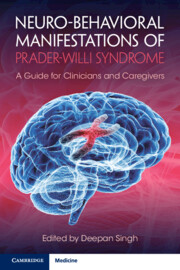Book contents
- Neuro-behavioral Manifestations of Prader-Willi Syndrome
- Neuro-behavioral Manifestations of Prader-Willi Syndrome
- Copyright page
- Dedication
- Contents
- Contributors
- Preface
- Acknowledgments
- Chapter 1 Knowing Your Patient
- Chapter 2 Caregiver Burden in Prader-Willi Syndrome
- Chapter 3 Establishing a Relationship with a Mental Healthcare Provider
- Chapter 4 Sleep Disorders in Prader-Willi Syndrome
- Chapter 5 Autism in Prader-Willi Syndrome
- Chapter 6 Anxiety in Prader-Willi Syndrome
- Chapter 7 Picking, Hoarding, and Elopement in Prader-Willi Syndrome
- Chapter 8 Attention-Deficit/Hyperactivity Disorder in Prader-Willi Syndrome
- Chapter 9 Agitation and Aggression in Prader-Willi Syndrome
- Chapter 10 Mood Disorders in Prader-Willi Syndrome
- Chapter 11 Psychotic Disorders in Prader-Willi Syndrome
- Chapter 12 Psychopharmacology in Prader-Willi Syndrome
- Chapter 13 A Caregiver’s Perspective
- Chapter 14 The Neurobiology of Prader-Willi Syndrome
- Chapter 15 Final Reflections on the Neuro-behavioral Manifestations of Prader-Willi Syndrome
- Index
- References
Chapter 9 - Agitation and Aggression in Prader-Willi Syndrome
Published online by Cambridge University Press: 26 May 2022
- Neuro-behavioral Manifestations of Prader-Willi Syndrome
- Neuro-behavioral Manifestations of Prader-Willi Syndrome
- Copyright page
- Dedication
- Contents
- Contributors
- Preface
- Acknowledgments
- Chapter 1 Knowing Your Patient
- Chapter 2 Caregiver Burden in Prader-Willi Syndrome
- Chapter 3 Establishing a Relationship with a Mental Healthcare Provider
- Chapter 4 Sleep Disorders in Prader-Willi Syndrome
- Chapter 5 Autism in Prader-Willi Syndrome
- Chapter 6 Anxiety in Prader-Willi Syndrome
- Chapter 7 Picking, Hoarding, and Elopement in Prader-Willi Syndrome
- Chapter 8 Attention-Deficit/Hyperactivity Disorder in Prader-Willi Syndrome
- Chapter 9 Agitation and Aggression in Prader-Willi Syndrome
- Chapter 10 Mood Disorders in Prader-Willi Syndrome
- Chapter 11 Psychotic Disorders in Prader-Willi Syndrome
- Chapter 12 Psychopharmacology in Prader-Willi Syndrome
- Chapter 13 A Caregiver’s Perspective
- Chapter 14 The Neurobiology of Prader-Willi Syndrome
- Chapter 15 Final Reflections on the Neuro-behavioral Manifestations of Prader-Willi Syndrome
- Index
- References
Summary
Agitation and aggression are common behavioral manifestations in patients with PWS. This chapter reviews how to recognize possible triggers and psychological mechanisms behind them. Caregivers are made aware of operant conditioning and the stages of moral development. Additionally the role of externalization is described. The underlying cause of the agitation can vary from person to person and similarly the management strategy differs considerably. The importance of ensuring the safety of the patient and others is emphasized. Behavioral management techniques can be very effective when started at an early age. Medications are effective options to supplement behavioral strategies as long as they are prescribed under the close monitoring of a medical provider. Finally, remember that most patients with PWS do not have malicious intent when they are exhibiting aggression. Their aggression is rooted in poor impulse control and hence is reactive in nature. Their aggression should be treated as a symptom rather than an inherent character flaw.
Keywords
- Type
- Chapter
- Information
- Neuro-behavioral Manifestations of Prader-Willi SyndromeA Guide for Clinicians and Caregivers, pp. 77 - 89Publisher: Cambridge University PressPrint publication year: 2022



